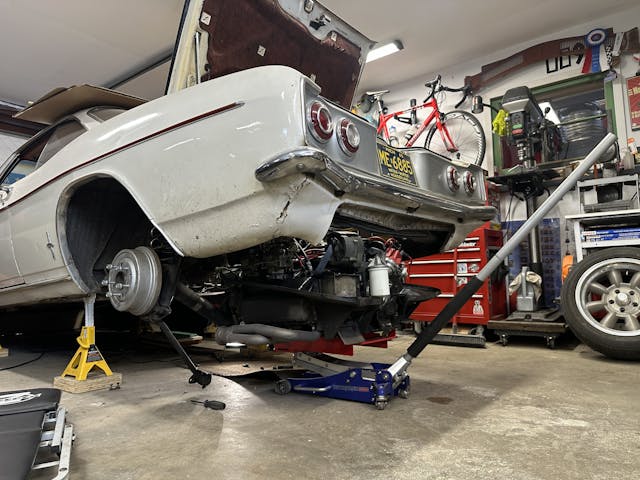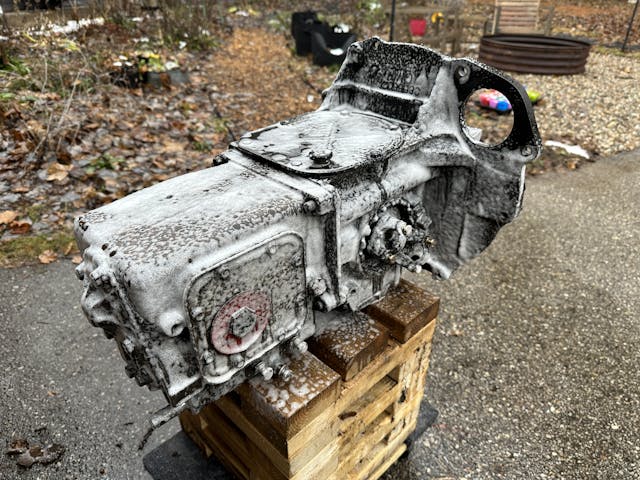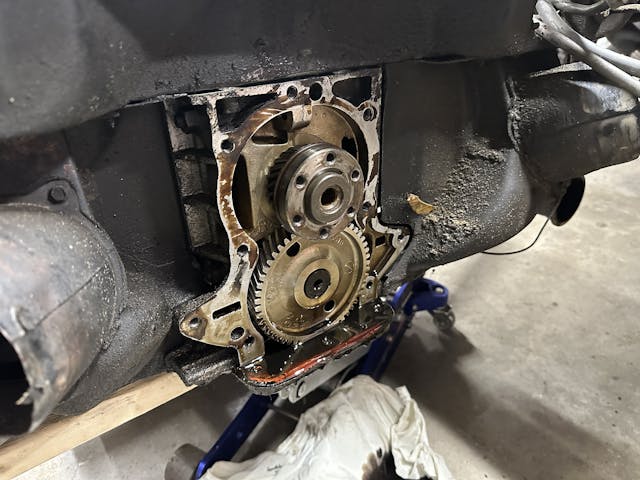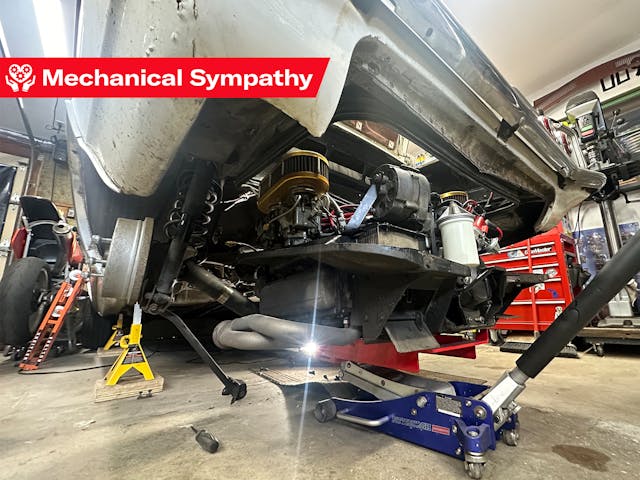Media | Articles
A To-Do List Saved My Corvair Love Affair
In the middle of one of those “just stand and stare at things” garage sessions that happen sometimes, the realization set in that my Corvair has been in my garage for nearly seven years. To much of the readership here that may seem like “just getting acquainted” time, but due to several factors, in the past I tended to buy, enjoy, and then send down the road after a year or two most of my vehicles. Not for profit (HA!), but rather just to try or experience something different. Surprisingly, that approach has had interesting consequences.
This comes up because I am still slightly emotionally scarred from allowing that Corvair to sit in the garage for over two years in an un-drivable state. Only after a friend harassed me about how long it had been parked did it come into focus that I had mentally moved on from Corvair projects. It wasn’t something I was even thinking about, let alone prioritizing during my time in the garage. Once prodded, however, the job was done in a couple days’ time, but there was something about the experience that made me make a mental note as to how I could keep it from happening again. This last week, proof arrived that I had succeeded; the planned winter project for the Corvair is almost done just as the snow is melting off. [Annnnd, the snow is back.—Ed.]

So what changed? Mainly the process used to track projects. Previously, I’d severely underestimated the power of writing things down. It’s great not only for the literal keeping track of things, but for the ability to see and document progress at times when none is visible. Using the latest Corvair project as an example:
Day 1: Pulled the engine and transmission. Big change, easily seen.
Days 2–71: Parts scattered across the floor and workbench, occasionally the dining room table. A plethora of small changes and fits-and-starts progress that are all nearly invisible. Notes kept throughout remind me that while they may feel invisible, they are not.
Day 72: Engine and transmission were reinstalled in the car. Big change easily seen.
Marketplace
Buy and sell classics with confidence
The flywheel replacement, the handful of gaskets and seals, along with a lot of cleaning and refinishing in between required a stick-to-it attitude that some might naturally have within themselves. The more times I tread this path the more I find it is lacking in me. My desire to work on large projects like this burns hot and fast. Sometimes that’s great as it means I can get a lot done in a fairly short amount of time. Other times it means things grind to a halt long before the project is done. So this time I put a focus on that. Not on the project itself, but on the part of my brain that easily tunes out. I had become that guy at the party who won’t let a song play all the way through before picking something else. Man, is he annoying.

So this time there was more documentation. More photos, more notes, and less discussion of the project. The idea was to actually do the tasks rather than talk about them. I’ve noticed that sometimes in the past talking about what I planned to do enough times would trip my brain into thinking I had already done the job. Then, when actually getting down to work, it felt as if I was walking well-trod ground instead of breaking the trail I should have expected. It’s always easier to talk about cleaning hardware and getting things assembled perfectly than it is to do those things.
Without a physical checklist in front of me tracking progress in poorly scrawled permanent ink on greasy cardboard, my brain was practicing creative accounting and crossing things off before I did them. Do this long enough and the brain declares the project complete, followed by short-circuiting after the eyes transmit the message that the car we are driving in our mind’s eye is actually a pile of parts in need of more time, money, and frustration. Everything is easy in your head; otherwise, I wouldn’t have already restored the 1964 Corvair Spyder that I saw on Marketplace this morning.


Keeping a list always seemed like a harsh reality check, like it was adding to life’s stress by sitting atop the thing that is supposed to bring joy—a reminder of all the things you haven’t done yet. That’s the wrong perspective. It is instead a way to remove the stress, not add to it. I can choose to only think about my project when I want to, without fear that I’ll forget where I was. Should the desire to chase something else arise, the list will be there, waiting for my return with a clear “You are here” on the adventure map that is a project car. You just have to make sure you return. Over the past few months, I have been. And it’s been better than ever.
To-do lists are things that nearly everyone tells rookies to utilize. Myself included. But before this winter, they just never seemed to work for me. Projects never progressed slowly enough to need them. Now, what started as a curious fling with a Corvair coupe has blossomed, seven years on, into a lasting relationship. If a car is going to be around for a while, it’s worth keeping better track of things. It’s sad it took me this long to figure that out. Luckily, now the fun begins.

***
Check out the Hagerty Media homepage so you don’t miss a single story, or better yet, bookmark it. To get our best stories delivered right to your inbox, subscribe to our newsletters.









I miss mine. It was my chance to own a classic American car. A Regal red, Monza Coup, with a 4sp. Last two owners did a lot to it so I didn’t have to mess with it for the 10 months I had it. The last owner put a rowdy exhasut on it to add to the fun. I had a lot of fun driving it and the car got a healthy amount of attention. Plenty of people didn’t even know what it was.
Corvairs really are such fun cars to drive and enjoy because they aren’t flashy but can catch all the attention a person could want if that’s what your into. Glad you got to enjoy one for awhile!
I’ve always had a semi-destructive love for these cars, as my grandfather left one in a barn for over 50 years. It was the first car I swung the steering wheel around on, making racing noises with my lips as only a kindergartener can. I was nearly badgered into buying the thing, laying in a muddy field, after he passed. I’m sort of sad I didn’t.
I bought a 1966 Corvair that had evidently been repinted in a dirt-floor booth, then sunk a bunch of money into it on half-baked ideas (rack and pinion steering? Why not?) before selling it at a crippling loss. Thereafter, all my wife had to do to win any marital argument was start chanting “Corvair! Corvair!” over and over until I surrendered.
Terry, sounds like she’s a tough one ! Ya gotta fight your way off the ropes with your own response : maybe shoes, shoes, shoes, or something of that nature. If you have nothing to throw back at her, you’re in for a long haul., buddy. Good Luck 🍀.
I was lucky as a buddy bought a 1966 Corvair convertible. It was wrecked in 1968 with 8K miles. In the 90’s my buddy bought it with the body work done but needed put together, It also had not run since 1968.
Praise the Lord for prayer and Marvel Mystery Oil.
We were able to free up the engine and it ran very well. We put the headlamps in a wind shield and in primer sold it for a lot more than he paid for it.
As for projects I am not one that can tear something down and leave it. Im OCD enough that as soon as it can go back together the better.
I have seen so many projects lose parts and not ever get finished that I fear I will become one of these failures. The OCD kicks in and as soon as the parts arrive back it goes together often in an overnight work binge.
I was lucky as a buddy bought a 1966 Corvair convertible. It was wrecked in 1968 with 8K miles. In the 90’s my buddy bought it with the body work done but needed put together, It also had not run since 1968.
Praise the Lord for prayer and Marvel Mystery Oil.
We were able to free up the engine and it ran very well. We put the headlamps in a wind shield and in primer sold it for a lot more than he paid for it.
As for projects I am not one that can tear something down and leave it. Im OCD enough that as soon as it can go back together the better.
I have seen so many projects lose parts and not ever get finished that I fear I will become one of these failures. The OCD kicks in and as soon as the parts arrive back it goes together often in an overnight work binge.
As for Corvairs. Dad had a new one every year from 1963-1966. He loved them but moved to Chevelles. The winter heat thing. I still remember riding in the cubby in the rear window when I was kid. Yes car seats were not common and most cars still were with seat belts as option.
As they say only the strong and lucky survived back then.
This is exactly what I needed to read as I slowly dive back in to the work my old land yacht needs before spring.
As I progress through pulling the dashboard, I am truly amazed at just how much stuff Mercedes could pack behind an 80s dash.
You’re very correct in that it’s much easier in our heads. “Oh I’ll just pull the cracked dash to replace with my clean one. While I’m there I’ll test all the vacuum pods and re-seal the HVAC bits. Then I’ll do some stereo wiring!”
Well if it’s so easy, why did I avoid starting on it for 2 months?
At the risk of repeating what I’ve been saying for decades-people that don’t like Corvairs have never driven one.
While never having had a Corvair, I have marshalled through a ’66 Mustang restoration. Once I replaced all the sheet metal, I had it painted. That when my MS-Excel took over as a tracking and progress sheet. I put everything I could think of that needed to be done to the bare shell of a car. Then assigned numbers to each item as to what should be done first to last. Edited and sorted it many times and added items I missed. It helped a lot to keep me on track. Printed copies made it garage friendly.
We have a few in my area and I have become pretty well acquainted with them. A good group of guys for a very cool car.
Back in the late 60s I bought a used 1966 Corvair Monza coupe with the 140 HP engine and 4 speed. At the same time we had a 1965 Mustang 289 4 speed. The Corvair required more maintenance attention than the Mustang but was a great handling car and I enjoyed driving it. I used both in minor competition activities, such as autocrosses and hillclimbs, and in organizing activities on Michigan rallies. The second generation cars with their revised suspensions, were great handling cars of their era.
The Corvair was eventually killed by a collision with a lady that pulled out in front of me and the body was twisted to where it was totaled. The remains were sold off as a parts car. I missed having it.
Life went on, other cars passed through our hands and I came to a point where I thought I would like another Corvair – a 1966 Corsa coupe (the final year), 140 HP engine, 4 speed. The 180 HP Turbo engine may be more desirable to collectors but the 140 is a better everyday engine with better low end torque and throttle response. The convertibles are generally more desirable than the coupes but the coupes are stiffer and handle better. The convertibles also carry the extra weight of a damper at each corner to lessen body shake. It is also my personal opinion that the late model Corvair coupe is one of the best styling efforts to come out of GM Styling in that era.
I found a California car with a solid body and bought it to add to my collection. I am currently sorting out the effects of many years of hack mechanics working on the car and feel that the solid body makes it all worthwhile.
I am looking forward to being able to drive a reliable, great handling, Corvair again and have already made friends with other Corvair owners in the area.
My first car, a ‘64 Monza convertible, I bought in 1979 and still have. I half-heartedly started a revamp on it back in the 90’s, as Bill Cotrofeld’s shop was only a few hours away. Not long after life got in the way, and I drove the car into a garage where it sits today, now about 25 years later. “I’ll get to it, someday” but that someday never seems to come.
I bought my ’65 Corvair new. Over 32 years and 275,000 miles, it was my daily driver, weekend autocrosser, occasional open-tracker and interstate transportation. With only a few upgrades: a pair of 3- barrel Porsche 911 Webers, 15X 7 & 15x 8 wheels, early Camaro 4-wheel disc brakes, plus 3 cranks, 2 transaxles and a host of other junkyard parts. Since it was also my work car, what kept me focussed was all work had to be ready for a 20 mile Monday morning slog. Other accomplishments were, I managed to stay married to the same woman during this time, and my kids all still speak to me. I still miss it (and the scars it gave me).
I’ve always loved the look of Webers on a Corvair. I assume you machined a set of 140 heads to fit them?
Sort of machined. First I paid my boys to hacksaw off the 140s cast intake manifolds. Then I TIG-ed 8″ pieces of curved aluminum conduit onto the stubs and onto a plate for each head. First iteration used Porsche intake manifolds on the plates and the second mounted the Webers directly- which lowered air cleaner heights & cut costs. Sorting out the jetting was done during each 20 mile trip home from work on rural roads via plug checks. I bought a set of pin drills and made tiny jet changes until I had both power and mileage- hard to do both with any Weber adaption. Final evaluation came at weekend autocrosses. Good times.
The list is a good idea. I had to start one after I faced the same “malaise” that you suffered.
And yep, it sure does feel good to cross an item off the list.
Really enjoy your Corvair articles, don’t see a lot of print about them anymore. I had a 61 I bought in 63, red with white interior, 900 coupe. Really enjoyed it. I recently bought a 63 900 coupe, white with red interior. A 28000 mile unrestored original. My only gripe is people think it is battery powered what with no front grille.
Lists! I have been making lists for most of my life–research notes, to-do lists, cautionary lists–you name it!I have sticky notes around my computer. Lists are great, Kyle–I fully agree with you! Now get this–and I saw this TV ad by a major drug company advertising a memory enhancing drug–saying that making lists, writing things down to remember, was an early sign of Alzheimer’s! That company, of course, is hoping to cash in on the new “everyone has mental issues” craze! I say–the person who knows how to make lists, is organizing his day, his week, even his year! Good for Lists! Let the “listless” persons wallow in their unorganized manner of life! LOL